
Arowanas are freshwater bony fish of the subfamily Osteoglossinae, also known as bony tongues. In this family of fish, the head is bony and the elongated body is covered by large, heavy scales, with a mosaic pattern of canals. The dorsal and anal fins have soft rays and are long based, while the pectoral and ventral fins are small. The name "bonytongues" is derived from a toothed bone on the floor of the mouth, the "tongue", equipped with teeth that bite against teeth on the roof of the mouth. The arowana is a facultative air breather and can obtain oxygen from air by sucking it into its swim bladder, which is lined with capillaries like lung tissue.

The silver arowana is a South American freshwater bony fish of the family Osteoglossidae. Silver arowanas are sometimes kept in aquariums, but they are predatory and require a very large tank.

The Asian arowana comprises several phenotypic varieties of freshwater fish distributed geographically across Southeast Asia. While most consider the different varieties to belong to a single species, work by Pouyaud et al. (2003) differentiates these varieties into multiple species. They have several other common names, including Asian bonytongue, dragonfish, and a number of names specific to the different color varieties.

The barramundi, Asian sea bass, or giant sea perch is a species of catadromous fish in the family Latidae of the order Perciformes. The species is widely distributed in the Indo-West Pacific, spanning the waters of the Middle East, South Asia, Southeast Asia, East Asia, and Oceania.

The great hammerhead is the largest species of hammerhead shark, belonging to the family Sphyrnidae, attaining an average length of 4.6 m (15 ft) and reaching a maximum length of 6.2 m (20 ft). It is found in tropical and warm temperate waters worldwide, inhabiting coastal areas and the continental shelf. The great hammerhead can be distinguished from other hammerheads by the shape of its "hammer", which is wide with an almost straight front margin, and by its tall, sickle-shaped first dorsal fin. A solitary, strong-swimming apex predator, the great hammerhead feeds on a wide variety of prey ranging from crustaceans and cephalopods, to bony fish, to smaller sharks. Observations of this species in the wild suggest that the cephalofoil functions to immobilize stingrays, a favored prey. This species has a viviparous mode of reproduction, bearing litters of up to 50 pups every two years.

The African arowana or Nile arowana is a species of bonytongue. Despite being called an "arowana", the African arowana is more closely related to arapaimas, the only other members in the subfamily Arapaiminae, than the South American, Asian, and Australian arowanas in the subfamily Osteoglossinae. Compared to these, the African arowana has a more terminal mouth and is the only one that feeds extensively on plankton.

Scleropages is a genus of fish in the family Osteoglossidae found in Asia and Australia. All of these species are carnivorous and have great jumping ability. These species are highly valued as aquarium fish, particularly by those from Asian cultures. In 2003, a study redescribed several naturally occurring color varieties of S. formosus into four separate species. The majority of researchers dispute these redescriptions, arguing that the published data are insufficient to justify recognizing more than one Southeast Asian species of Scleropages and that divergent haplotypes used to distinguish the color strains into isolated species were found within a single color strain, contradicting the findings. They are considered monotypic, consisting of closely related haplotypes based on color. The ancestor of the Australian arowanas: S. jardinii and S. leichardti, diverged from the ancestor of the Asian arowanas about 140 million years ago, during the Early Cretaceous period. The morphological similarity of all seven species shows that little evolutionary change has taken place recently for these ancient fish. The genus had a much wider distribution during the early Cenozoic, with fossil remains known from the Paleocene of Niger and Belgium, and from the Eocene of China.
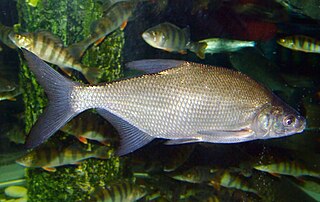
The common bream, also known as the freshwater bream, bream, bronze bream, carp bream or sweaty bream, is a European species of freshwater fish in the family Cyprinidae. It is now considered to be the only species in the genus Abramis.
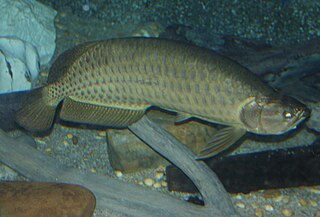
The southern saratoga, also known as the spotted bonytongue, spotted saratoga, or simply saratoga, is a freshwater bony fish native to Australia. It belongs to the subfamily Osteoglossinae, or arowanas, a primitive group of teleosts. Like all arowanas, it is a carnivorous mouthbrooder. Along with the gulf saratoga, the saratoga is also known as the Australian arowana and barramundi, although the latter name is nowadays reserved in Australia for the unrelated Lates calcarifer.

The mangrove red snapper, also known as mangrove jack, grey snapper, creek red bream, Stuart evader, dog bream, purple sea perch, red bream, red perch, red reef bream, river roman, or rock barramundi, is a species of marine ray-finned fish, a snapper belonging to the family Lutjanidae. It has a wide Indo-Pacific range and has recently been recorded in the eastern Mediterranean Sea.
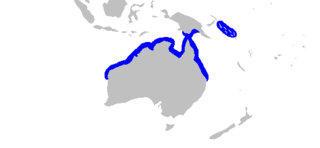
The nervous shark is a species of requiem shark, and part of the family Carcharhinidae, so named because of its timid behavior in regard to humans. It is common in shallow, coastal waters off northern Australia, Papua New Guinea, and the Solomon Islands. A small brownish or grayish shark typically measuring 1.0–1.3 m (3.3–4.3 ft) long, this species has a short, blunt snout, oval eyes, and a relatively large second dorsal fin. The leading margins of most fins are finely edged with black, and the lower caudal fin lobe is black-tipped.
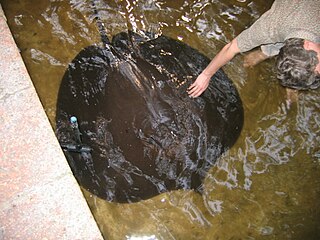
The giant freshwater stingray is a species of stingray in the family Dasyatidae. It is found in large rivers and estuaries in Southeast Asia and Borneo, though historically it may have been more widely distributed in South and Southeast Asia. The largest freshwater fish and the largest stingray in the world, this species grows up to 2.2 m (7.2 ft) across and can reach up to 300 kg (660 lb) in weight. It has a relatively thin, oval pectoral fin disc that is widest anteriorly, and a sharply pointed snout with a protruding tip. Its tail is thin and whip-like, and lacks fin folds. This species is uniformly grayish brown above and white below; the underside of the pectoral and pelvic fins bear distinctive wide, dark bands on their posterior margins.
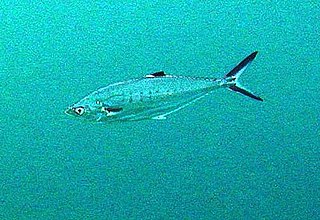
The doublespotted queenfish is a tropical game fish in family Carangidae (jacks). It is associated with reefs and ranges widely throughout the Indian and Pacific Oceans. Other common names for this fish are giant dart, large-mouthed leatherskin, leatherskin, queenfish, skinny fish, skinnyfish, St. Peter's leatherskin, white fish or whitefish. イケカツオ is in Japanese.
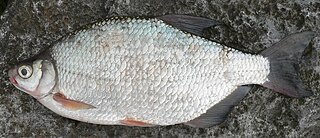
Blicca bjoerkna, alternatively called the white bream or the silver bream, is a European species of freshwater fish in the family Cyprinidae.
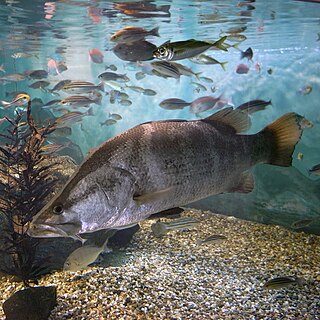
The Japanese lates, also known as the akame or Japanese barramundi, is a species of fish found in Japan. A bottom-dweller restricted to estuarine habitats and large rivers in the Pacific coastal western parts of the country, it is threatened by habitat destruction. As it is similar to the related barramundi, it was classified as the same species until 1984.
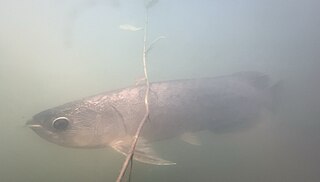
The Batik Arowana or Myanmar arowana(Scleropages inscriptus), is a large, bony-tongued fish native to Myanmar. The species is found in the Tanintharyi River basin on the Indian Ocean coast of peninsular Myanmar.

Ambassis macleayi, commonly known as Macleay's glassfish, Macleay's glass perchlet, Macleay's perchlet, reticulated glassfish, reticulated perchlet, or network perchlet, is a species of freshwater fish in the family Ambassidae. It is native to northern Australia and the trans-Fly River region of New Guinea. It is a fish with a vertically flat, narrow body and a standard length generally between 35 and 45 mm, with large specimens reaching 77 mm (3.0 in) long. It generally eats water fleas and other small invertebrates. This fish is considered to be a least-concern species according to the International Union for Conservation of Nature (IUCN), although it could suffer from habitat degradation due to feral pigs and invasive water plants such as the water hyacinth. The fish is suitable for aquarium use in tanks containing other non-aggressive species.
Neoarius leptaspis, the salmon catfish, boofhead catfish, freshwater forked tailed catfish, lesser salmon catfish, or triangular shield catfish, is a species of catfish in the family Ariidae. It was described by Pieter Bleeker in 1862, originally under the genus Hexanematichthys. It inhabits marine, brackish and freshwaters in Australia and New Guinea, at a maximum known depth of 135 m (443 ft). It reaches a maximum standard length of 60 cm (24 in).
Barramundi is a saltwater fish of the Indian and western Pacific oceans also called the Asian sea bass. Barramundi, meaning "large-scaled river fish", may also refer to:


















